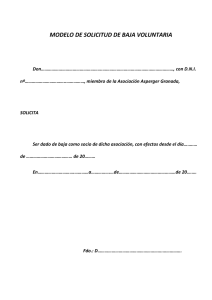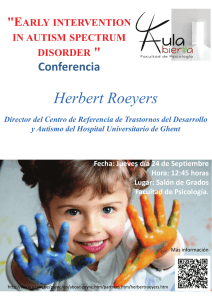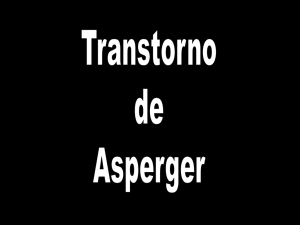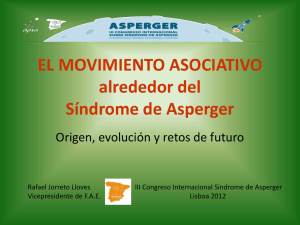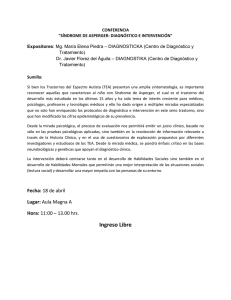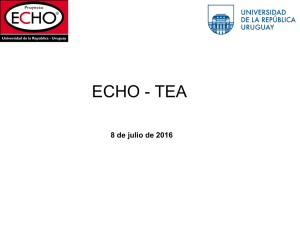para descargar pulse aquí
Anuncio
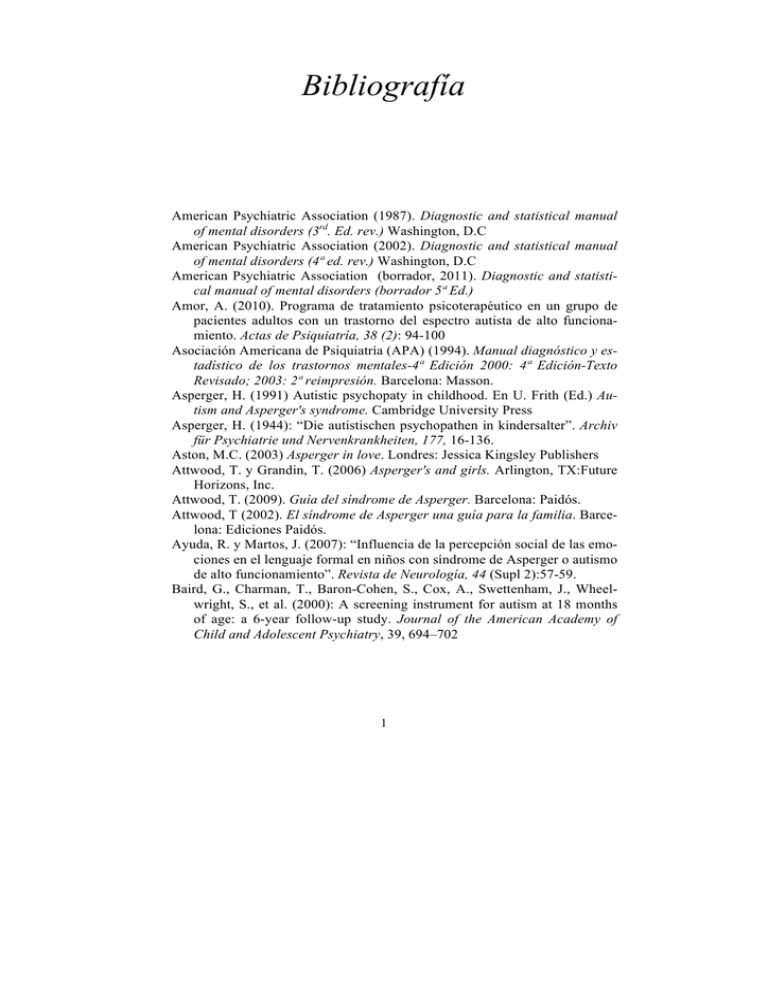
Bibliografía American Psychiatric Association (1987). Diagnostic and statistical manual of mental disorders (3rd. Ed. rev.) Washington, D.C American Psychiatric Association (2002). Diagnostic and statistical manual of mental disorders (4ª ed. rev.) Washington, D.C American Psychiatric Association (borrador, 2011). Diagnostic and statistical manual of mental disorders (borrador 5ª Ed.) Amor, A. (2010). Programa de tratamiento psicoterapéutico en un grupo de pacientes adultos con un trastorno del espectro autista de alto funcionamiento. Actas de Psiquiatría, 38 (2): 94-100 Asociación Americana de Psiquiatría (APA) (1994). Manual diagnóstico y estadístico de los trastornos mentales-4ª Edición 2000: 4ª Edición-Texto Revisado; 2003: 2ª reimpresión. Barcelona: Masson. Asperger, H. (1991) Autistic psychopaty in childhood. En U. Frith (Ed.) Autism and Asperger's syndrome. Cambridge University Press Asperger, H. (1944): “Die autistischen psychopathen in kindersalter”. Archiv für Psychiatrie und Nervenkrankheiten, 177, 16-136. Aston, M.C. (2003) Asperger in love. Londres: Jessica Kingsley Publishers Attwood, T. y Grandin, T. (2006) Asperger's and girls. Arlington, TX:Future Horizons, Inc. Attwood, T. (2009). Guía del síndrome de Asperger. Barcelona: Paidós. Attwood, T (2002). El síndrome de Asperger una guía para la familia. Barcelona: Ediciones Paidós. Ayuda, R. y Martos, J. (2007): “Influencia de la percepción social de las emociones en el lenguaje formal en niños con síndrome de Asperger o autismo de alto funcionamiento”. Revista de Neurología, 44 (Supl 2):57-59. Baird, G., Charman, T., Baron-Cohen, S., Cox, A., Swettenham, J., Wheelwright, S., et al. (2000): A screening instrument for autism at 18 months of age: a 6-year follow-up study. Journal of the American Academy of Child and Adolescent Psychiatry, 39, 694–702 1 El síndrome de Asperger. Evaluación y tratamiento Baron-Cohen, S. (1989): “The autistic child’s theory of mind a case of specific developmental delay”. Journal of Child Psychology and Psychiatry and Allied Disciplines, 30(2), 285-297. Baron-Cohen, S. y Scahill, V.L (1999)The Prevalence of Gilles de la Tourette Syndrome in children and adolescents with autism: A large scale study. Psychological Medicine, 29, 1151-1159. Baron- Cohen, S. (2002) Is Asperger Syndrome Necessarily Viewed as a Disability? Focus on Autism and Other Developmental Disabilities, 17, Nº3, 186-191 Baron- Cohen, S. (2009) The Short Life of a Diagnosis. New York Times. Baron-Cohen, S. (2010): Autismo y Síndrome de Asperger. Alianza. Madrid. Baron-Cohen, S., Leslie, A. y Frith, U. (1985): “Does the autistic child have a theory of mind?” Cognition, 21, 37-46. Baron-Cohen, S., Jolliffe, T., Mortimore, C. y Robertson, M. (1997): “Another advanced test of theory of mind: evidence from very high adults with autism or Asperger syndrome” Journal of Child Psychology and Psychiatry and Allied Disciplines, 38(7), 813-822. Baron-Cohen, S., Ashwin, E., Ashwin, C., Tavassoli, T. y Chakrabarti, B. (2009): Talent in autism: hyper-systemizing, hyper-attention to detail and sensory hypersensitivity. Philosophical Transactions of Royal Society B. 364, 1377–1383. Baron-Cohen, S., Wheelwright, S., Skinner, R., Martin, J., y Clubley, E.(2001) The Autism-Spectrum Quotient (AQ): Evidence from Asperger Syndrome/High-Functioning Autism, Males and Females, Scientists and Mathematicians. Journal of Autism and Developmental Disorders; 31(1):5–17 Baron-Cohen, S., Wheelwright, S., Robinson, J. y Woodbury-Smith, M. R. (2005) The Adult Asperger Assessment (AAA): A Diagnostic Method. Journal of Autism and Developmental Disorders; 35(6):807–819 Belinchón, M., Hernández, J.M y Sotillo, M. (2008). Personas con síndrome de Asperger. Funcionamiento, detección y necesidades. Centro de Psicología Aplicada de la Universidad Autónoma de Madrid, Confederación Autismo España, Federación Española de Asociaciones de Padres de Autistas y Fundación Once. Belinchón, M., Hernández, J.M y Sotillo, M. (2009). Síndrome de Asperger. Una guía para los profesionales de la educación. Centro de Psicología Aplicada de la Universidad Autónoma de Madrid, Confederación Autismo España, Federación Española de Asociaciones de Padres de Autistas y Fundación Once. 2 Bibliografía Belmonte, M. K., Allen, G., Beckel-Mitchener, A., Boulanger, L. M., Carper, R. A. y Webb, S. J. (2004): Autism and abnormal development of brain connectivity. Journal of. Neuroscience. 24, 9228–9231. Bishop, D. y Norbury, C.F (2002): Exploring the borderlands of autistic disorder and specific language impairment: a study using standardised diagnostic instruments. Journal of child psychology and psychiatry, 3, 917-931. Bogashina, O. (2007). Problemas de percepción sensorial en el autismo y síndrome de Asperger: diferentes experiencias sensoriales, diferentes mundos perceptivos. Ávila: Asociación Autismo Ávila. Booth, R., Charlton, R., Hughes, C., y Happé, F. (2003): “Disentangling weak coherence and executive dysfunction: planning drawing in autism and attention-deficit/hyperactivity disorder” Philosophical Transactions of the Royal Society of London Series B-Biological Sciences, 358(1430), 387–392. Boucher, J., Lewis, V., y Collis, G. M. (2000): “Voice processing abilities in children with autism, children with specific language impairments, and young typically developing children”. Journal of Child Psychology and Psychiatry and Allied Disciplines, 41(7), 847–857. Campbell, J. (2005). Diagnostic assessment of Asperger’s disorder: A review of five third-party rating scales. Journal of Autism and Delevopmental Disorders, 35 (1), 25-35. Casanova, M. F., Switala, A. E., Trippe, J. y Fitzgerald, M. (2007): Comparative minicolumnar morphometry of three distinguished scientists. Autism 11, 557–569. Casanova, M. & Trippe, J. 2009 Radial cytoarchitecture and patterns of cortical connectivity in autism. Philosophical Transactions of Royal Society B 364, 1433–1436. Castelli, F., Frith, C., Happé, F. y Frith, U. (2002): “Autism, Asperger syndrome and brain mechanism for the attribution of mental states to animated shapes”, Brain, 125, 1839-1849. Cererols, R. (2010) Descubrir el Asperger. Libro digital disponible en http://www.pairal.net/ Chappell, A.L. (1998) Still out in the cold: People with learning dificulties and the social model of disability. The disability reader. Social science perspective (pp. 211- 2219) London: Cassell Crissey P (2005). Personal Hygiene?. What´s that got to do with me?. London: JKP Dekker, M. (2000) On owr own terms: Emerging autistic culture. http://sheilaschoonmaker.com/files/copies/martijn.html Del Río Galve, C. (2006). ¿Quieres conocerme? Síndrome de Asperger. Barcelona: Miguel A. Salvatella. S.A. 3 El síndrome de Asperger. Evaluación y tratamiento Deruelle, C., Rondan, C., Gepner, B., y Tardif, C. (2004): Spatial frequency and face processing in children with autism and Asperger syndrome. Journal of Autism and Developmental Disorders, 34(2), 199–210. Dewey, M. (1991) Living with Asperger´s syndrome. En Uta Frith (Ed.), Autism an Asperger syndrome, pp. 184-206. New York: Cambridge University Press. Diez Cuervo, A. (2005): “Estado actual de la investigación genética en los trastornos de espectro autista”, en Martos, J., González, P. M., Llorente, M. y Nieto, C. (Comp.) Nuevos desarrollos en autismo: el futuro es hoy. Imserso-APNA. Madrid. Díez-Cuervo, A., Muñoz-Yunta, J.A.B., Fuentes-Biggi, J. Canal-Bedia, R., Idiazábal-Aletxa, M.A., Ferrari-Arroyo, M.J., Mulas, F., tamarit, J., Valdizán, J.R., Hervás-Zuñiga, A., Artigas-Pallarés, J., Belinchón-Carmona, M., Hernández, J.M., Martos-Pérez, J., Palacios, S., Posada-De la Paz, M., (2005) (Grupo de Estudio de los Trastornos del Espectro Autista del Instituto de Salud Carlos III. Ministerio de Sanidad y Consumo, España). Guía de buena práctica para el diagnóstico de los trastornos del espectro autista. Revista de neurología, 41 (5):299–310. Dorado, M. (2004). Otra forma de mirar. Memorias de un joven con síndrome de Asperger. Editorial librosalacarta.com. Eisenmajer, R. et al. (1996) Comparison of Clinical Symptoms in Autism and Asperger's Disorder. Child Adolesc. Psychiatry, 35:11 Equipo Deletrea (2006). El síndrome de Asperger: otra forma de aprender. Madrid: CAM. Equipo Deletrea (2008). Los niños pequeños con autismo: soluciones prácticas para problemas cotidianos. Madrid: CEPE. Faherty, C. (2000) Asperger´s What does ir mean to me? Future Horizons Freeman S y Dake L (1996). Teach me language. Langley, BC: SKF Books. Frith, U. [1989] (2003): Autism: Explaining the enigma. Blackwell. Oxford. [Ed. cast.: Autismo: Hacia una explicación del enigma. Alianza Editorial. Madrid. 1992. Frith, U. (2004). Emanuel Miller lecture: Confusions and controversies about Asperger syndrome. Journal of Child Psychology and Psychiatry, 45 (4):672–686 García- Villamisar, D.; Vranckem, P.; Ross, D. Manual para la formación de preparadores laborales de personas adultas con autismo. Aspectos teóricos y prácticos. Promolibro Valencia. 2002. Gaus, V. L. (2007). Cognitive-Behavioral Therapy for Adult Asperger Syndrome. Guilford Press. Nueva York. 4 Bibliografía Gillberg, C. (1991b). Outcome in autism and autistic-like conditions. Journal of the American Academy of Child and Adolescent Psychiatry, 30, 375382 Gillberg y Gillberg (1989). Asperger Syndrome- Some epidemiological considerations. Journal of Child Psychology and Psychiatry, 30, 631- 638 Gillberg, C. y Ehlers, S. (1998): High-functioning people with autism and Asperger´s syndrome, en E. Schopler y G. Mesivob (eds), Asperger syndrome or high-functioning autism. (págs. 77-100). Nueva York: Plenum Press. Gillberg, CH. Gillberg, C. Rastam, M. y Wentz, E. (2001). Asperger Syndrome diagnostic interview. ASDI Autism, vol 5 (1); pp 57-66. Gillberg, C.;Råstam, M.(1992) Do some cases of anorexia nervosa reflect underlying autistic-like conditions? Behavioural Neurology, Vol 5(1), 27-32. Golan, O., Baron-Cohen, S y Golan, Y. (2008): “The ‘Reading the Mind in Films’ Task [Child Version]: Complex Emotion and Mental State Recognition in Children with and without Autism Spectrum Conditions” Journal of Autism and Developmental Disorders, 38, 1534-1541. González, A. (2009) El síndrome de Asperger. Guía para mejorar la convivencia escolar dirigida a familiares, profesores y compañeros. Editorial CEPE Golan, O., Baron-Cohen, S., Hill, J. y Rutherford M. (2007): “The ‘Reading the Mind in the Voice’ Test-Revised: A Study of Complex Emotion Recognition in Adults with and without Autism Spectrum Conditions” Journal of Autism and Developmental Disorders, 37, 1096-1106. Grandin, T. (1996). Thinking in Pictures and Other Reports from My Life with Autism. Toronto: First Vintage Books. Grandin, T. (1997). Atravesando las Puertas del Autismo. Editorial: Paidos Grandin, T. (2006). Pensar con imágenes. Mi vida con el autismo. Alba Editorial Gray C (1998). Social Stories and comic strip conversations with students with Asperger Syndrome and High-Functioning Autism. En: E. Shcopler, GB Mesibov y L. Kunce. Asperger Syndrome or High Functioning Autism?. Nueva York: Plenum Press. Grossman, J. B., Klin, A., Carter, A. S., y Volkmar, F. R. (2000): “Verbal bias in recognition of facial emotions in children with Asperger syndrome”. Journal of Child Psychology and Psychiatry and Allied Disciplines, 41, 369–379. Grice, H. (1975). Logic and conversation. En D. Davidson y G. Harmon (Eds).), The logic of gramar. Encino, CA: Dickenson. Happé, F. (1994): An advanced test of theory of mind–understanding of story characters thoughts and feelings by able autistic, mentally-handicapped 5 El síndrome de Asperger. Evaluación y tratamiento and normal children and adults. Journal of Autism and Developmental Disorders, 24(2), 129-154. Happé, F. (1995): The role of age and verbal ability in the theory of mind task performance of subjects with autism. Child Development 66(3), 843-855. Happé, F. (1996): Studying weak central coherence at low levels: children with autism do not succumb to visual illusions. A research note. Journal of Child Psychology and Psychiatry and Allied Disciplines, 37(7), 873– 877. Happé, F. (1999): Autism: cognitive deficit or cognitive style?, Trends in Cognitive Sciences, 3(6), 216-222. Happé, F. y Frith, U. (2006): The weak coherence account: detail-focused cognitive style in autism spectrum disorders. Journal of Autism and Developmental Disorders, 36(1), 5–25. Happé, F., Ehlers, S., Fletcher, S., Frith, U., Johannsson, M., Gillberg, C. et al. (1996): Theory of mind in the brain. Evidence from a PET scan study of Asperger syndrome. Neuroreport, 8, 197-201. Happé, F., Ronald, A., y Plomin, R. (2006). Time to give up on a single explanation for autism. Nature Neuroscience, 9(10), 1218–1220. Happé, F. y Vital, P. (2009): What aspects of autism predispose to talent? Philosophical Transactions of The Royal Society B. 364, 1369–1375. Heinze, H. J., Hinrichs, H.; Scholz, M., Burchert, W y Mangun, R. (1998): Neural mechanisms of global anl olocal processing: a combined PET an ERP study. Journal of Cognitive Neuroscience, 10, 485-498. Hénault, I. (2006). Asperger´s Syndrome and Sexuality. from adolescence through adulthood. Londres: Jessica Kingsley Publishers Hénault, I. y Attwood, T. (2006). The sexual profile of adults with Asperger´s Syndrome: The ned for support and intervention. En Hénault, I. Asperger´s Syndrome and Sexuality. from adolescence through adulthood. Londres: Jessica Kingsley Publishers. Hellemans, H., Colson, K., Verbraeken, C., Vermeiren, R. y Deboutte, D. (2007). Sexual behavior in high-functioning male adolescents and young adults with autism spectrum disorders. Journal of Autism and Developmental Disorders, 37: 260-269. Hernández JM et. al. (2005). Guía de buena práctica para la detección precoz de los Trastornos del espectro autista. Revista de. Neurología, 41 (4): 237245 Hill, E. L. y Frith, U. (2004): Understanding autism: insights from mind and brain. En Frith, U. y Hill, E. (Ed.) Autism: mind and brain. Oxford University Press. 6 Bibliografía Hobson, R. P., Ouston, J., y Lee, A. (1988): Emotion recognition in autism: co-ordinating faces and voices. Psychological Medicine, 18, 911–923. Holliday, L. (1999) Pretending to be normal. Londres: Jessica Kingsley Publishers. Holiday, L., Gray, C. y Attwood, T. (1999). The discovery of “Aspie” criteria. The Morning News, 11, 1-7 Howlin, P. (1997) Autism and Asperger Syndrome. Preparing for adulthood. Londres y Nueva York: Routledge. Howlin, P. (2000). Outcome in adult life for more able individuals with autism or Asperger syndrome. Autism, 4 (1), 63-83. Howlin P, Baron-Cohen S, Hadwin J (1999). Enseñar a los niños autistas a comprender a los demás. Guía práctica para educadores. Barcelona: ediciones CEAC. Howlin, P., Goode, S., Hutton, J. & Rutter, M. (2009): Savant skills in autism: psychometric approaches and parental reports. Philosophical Transactions of Royal Society B 364, 1359–1367. Hurlburt, R.T., Happé, F. y Frith, U. (1994). Sampling the form of inner experience in three adults with Asperger syndrome. Psychological Medicine, 24, 385-395. Hurlbutt, K, Chalmers, L., (2004) Employment and Adults with Asperger Syndrome. Focus on Autism and Other Developmental Disabilities, Vol. 19, N. 4, 215- 222 Johnson, D.J. y MyKlebust, H.R. Learning disabilities: Educational principles and practise. New York: Grune and Stratton; 1971. Kanner, L. (1943): Autistic disturbances of affective contact. Nervous Child, 2, 217-250. Kasari, C., Chamberlain, B., y Bauminger, N. (2001): Social emotions and social relationships: Can children with autism compensate?. En J. A. Burack, T. Charman, N. Yirmiya, y P. R. Zelazo (Eds.), The development of autism: Perspectives from theory and research (pp. 309–323). Mahwah, NJ, US: Lawrence Erlbaum. Kelleher III, R. J. y Bear, M. F. (2008) The autistic neuron: troubled translation? Cell 135, 401–406. Keterlaars, C., Horwitz, E, Sytema, S., Bos, J., Wiersma, D., Minderaa, R. y Hartman, C.A. (2008). Brief report: Adults with Mild Autism Spectrum Disorders (ASD): Scores on the Autism Spectrum Quotient (AQ) and Comorbid Psychopathology. Journal of Autism and Developmental Disorders 38:176-180. Kiker K (2006). Social Skills Groups for children and adolescents with Asperger´s Syndrome. A step-by-step program. London: JKP 7 El síndrome de Asperger. Evaluación y tratamiento Klin, A. (1994). Asperger Syndrome, Child and Adolescent. Psychiatric Clinics of North America, 3, 131-148 Klin, A. y Volkmar, F. (1997) Autism and pervasive Developmental Disorders. ED Donald J. Cohen y Fred R. Volkmar Klin, A., Saulnier, C., Tsatsanis, K., y Volkmar, F. (2005): Clinical evaluation in autism spectrum disorders: psychological assessment within a transdisciplinary framework. In F. R. Volkmar, P. Rhea, A. Klin, y D. Cohen (Eds.), Handbook of autism and pervasive developmental disorders (pp. 772–798). New Jersey: Wiley. Ladell Sanders, J. (2009) Qualitative or Quantitative Differences Between Asperger's Disorder and Autism? Historical Considerations. Journal of Autism Development Disorders, 39: 1560- 1567 López, B. y Leekam, S. R. (2003): “Do children with autism fail to process information in context?” Journal of Child Psychology and Psychiatry and Allied Disciplines, 44(2), 285–300. Lord, C., Le Coutier, A. y Rutter, M. (2008) Entrevista para el Diagnóstico del Autismo-Revisada (ADI-R) Tea-ediciones. Lord, C., Rutter, M., DiLavore, P. y Risi, S. (2010). Escala de Observación para el diagnóstico del Autismo (ADOS). Tea-ediciones. Macintosh, K.E y Dissanayake, C. (2004) Annotation: The similarities and differences between autistic disorder and Asperger's disorder: a review of the empirical evidence. Journal of Child Psychology and Psychiatry, 45, 3, 421–434. Martín Borreguero, P. (2004) El síndrome de Asperger ¿Discapacidad o excentricidad social? Alianza Editorial Martos, J. y Paula, I. (2011): “Una aproximación a las funciones ejecutivas en el trastorno de espectro autista”, Revista de Neurología, 52 (Supl 1): 147153. Meyer, J.A, Mundy, P.C., Van Hecken, A.V. Durocher, J.S. Sisical attribution processes and comorbid psychiatric symptoms in children with autism and Asperger syndrome. Autism 2006; 10: 383-402. Monfort, M, (2001 ). En la mente 1. Madrid: Entha ediciones. Monfort M (2001). En la mente 2. Madrid: Entha ediciones. Monfort M, Juárez A y Monfort I (2004). Niños con Trastornos pragmáticos del lenguaje y de la comunicación. Madrid: Entha ediciones. Monjas MI (2006). Programa de enseñanza de interacción social (PEHIS). Para niños/as y adolescentes. Madrid: CEPE. Mottron, L., Dawson, M., Soulieres, I., Hubert, B., y Burack, J. (2006): “Enhanced perceptual functioning in autism: an update, and eight principles of autistic perception”, Journal of Autism and Developmental Disorders, 36(1), 27–43. 8 Bibliografía Mottron, L., Dawson, M. y Soulieres, I. (2009): Enhanced perception in savant syndrome: patterns, structure and creativity. Philosophical Transactions of The Royal Society B. 364, 1385–1391. Müller, E., Shuler, A., Burton, B., Yates, G. (2003) Meeting the vocational support needs of individuals with Asperger Syndrome and other autism spectrum disabilities. Journal of Vocational Rehabilitation 18 163- 175 National Autistic Society, The undiscovered workforce. (En Internet) New York Times Magazine (5 agosto, 2007) What autistic girls are made of? Norbury, C. F. (2005): “Barking up the wrong tree? Lexical ambiguity resolution in children with language impairments and autistic spectrum disorders” Journal of Experimental Child Psychology, 90(2), 142–171. OMS (Organización Mundial de la Salud) (1992). Trastornos mentales y del comportamiento. Madrid: Meditor Paula Pérez, I. y Martos Pérez, J. (2009) Síndrome de Asperger y autismo de alto funcionamiento: comorbilidad con trastornos de ansiedad y del estado de ánimo. Revista de neurologia, 48:S31–S34 Paula, I., Martos, J. y Llorente, M. (2010): “Alexitimia y síndrome de Asperger”. Revista de Neurología, 50 (supl.3): S85-90. Pellicano, E., Maybery, M., Durkin, K., y Maley, A. (2006): “Multiple cognitive capabilities/deficits in children with an autism spectrum disorder: “weak” central coherence and its relationship to theory of mind and executive control” Development and Psychopathology, 18(1), 77–98. Plaisted, K. (2001): “Reduced generalization in autism: an alternative to weak central coherence”, en Burack, J., Charman, T., Yirmiya, N. y Zelazo, P. (ed) The development of autism: perspectives from theory and research. Lawrence Erlbaum Associates: Mahwah. Polimeni, M.A., Richdale, A.L y Francisc, A. J. P (2005). A surrey of sleep problems in autism, Asperger´s syndrome and tipically developing children. Journal of intellectual disability research. 49, 260-268. Powell, A. (2002). Taking Responsibility. Good practice guidelines for services – adults with Asperger syndrome. Londres: The National Autistic Society Rapin, I. y Alen, D. (1983): Developmental language disorder: Nosologic considerations. En U. Kirk (ed.), Neuropsychologi of language, reading and spelling . New York: Academic Press. Rigau E., García C., Artigas, J. Características del trastorno de aprendizaje no verbal. Rev Neurol Clin 2004; 38 (supl 1). Ring, H. A., Baron-Cohen, S., Wheelwright, S., Williams, S. C., Brammer, M., Andrew, C. et al. (1999): “Cerebral correlates of preserved cognitive skills in autism: a functional MRI study of embedded figures task performance”. Brain 122, 1305-1315. 9 El síndrome de Asperger. Evaluación y tratamiento Ritvo, R., Ritvo, E., Guthrie, D., Ritvo, M., Hufnagel, D., McMahon, W., Tonge, B., Mataix-Cols, D., Jassi, A., Attwood, T. y Eloff, J. (2011) The Ritvo Autism Asperger Diagnostic Scale-Revised (RAADS-R): A Scale to Assist the Diagnosis of Autism Spectrum Disorder in Adults: An International Validation Study. Journal of Autism and Developmental Disorders, 41, 8, 1076-1089. Robbins, T. W. (2000): “Integración de las dimensiones neurobiológica y neuropsicológica del autismo” En J. Russell. El autismo como trastorno de la función ejecutiva. Editorial Médica Panamericana: Madrid Ropar, D. y Mitchell, P. (2001): “Susceptibility to illusions and performance on visuospatial tasks in individuals with autism”, Journal of Child Psychology and Psychiatry and Allied Disciplines, 42(4), 539–549 Rourke, B.P. The syndrome of nonverbal learning disabilities: developmental manifestations in neurological disease, disorder and disfunction. Clin Neuropsychol; 24: 280-5. Russell, J. (2000): El autismo como trastorno de la función ejecutiva. Editorial Médica Panamericana: Madrid. Rutherford, M., Baron-Cohen, S. y Wheelwright, S. (2002). “Reading the Mind in the Voice: A study with normal adults and adults with Asperger syndrome and high functioning autism”, Journal of Autism and Developmental Disorders, 37, 1096-1106. Rutter, M. (1978a). Diagnostic validity in child psychiatry. Advances in Biological Psychiatry, 2, 2-22. Saiz C, Román JM (2010 ). Habilimen. Programa de desarrollo de habilidades mentalistas en niños pequeños. Madrid: CEPE. Shallice, T. (1988): From neuropsychology to mental structure. Cambridge University Press. Silani, G., Bird. G., Brindley, R., Singer, T., Frith, C. y Frith, U. (2008): “Levels of emotional awareness and autism: an fMRI study”. Social Neuroscience, 3, 2, 97-112. Smith J, Donlan J, Smith B (2008). Create a Reward Plan for your child with Asperger Syndrome. London: JKP. Slater-Walker, G. y Slater-Walker, C. (2002). An Asperger Marriage. Londres: Jessica Kingsley Publishers Solcoff, K. (2001). Memoria Autobiográfica y Espectro Autista. En Daniel Valdez (coord.). Autismo: enfoques actuales para padres y profesionales de la salud y la educación. Buenos Aires: Fundec. Solomon, M.; Ozonoff, S., Carter, C. y Caplan, R. (2008): “Formal thought disorder and the autism spectrum: relationship with symptoms, executive control and anxiety”. Journal of Autism and Developmental Disorders, 38, 1474-1484. 10 Bibliografía Stanford, A. (2002). Asperger and Long-Term Relationships. Londres: Jessica Kingsley Publishers Stewart, M.E., Barnard L., Pearson, J., and cols. Presentation of depression in autism and Asperger syndrome: a review. Autism 2006; 101: 103-16. Stone, V.E., Baron-Cohen, S. y Knight, R.T. (1998). Frontal lobe contributions to theory of mind. Journal of Cognitive Neuroscience, 10, 640-656. Stoken, MA. y Kaur A. (2005). High-functioning autism and sexuality: a parental perspective. Autism, 9: 266-289 Sullivan, A. y Caterino, L.C. (2008). Addressing the sexuality and sex education of individuals with autism spectrum disorders. Education and Treatment of Children, 31 (3): 381-394 Szatmari, P, Bremmer, R. y Nagy, J.M. (1989). Asperger's Syndrome: A review of clinical features. Canadian Journal of Psychiatry, 34 (6), 554-560 Szatmari, , P. (1998): Differemtial diagnosis of Asperger Syndrome. En E. Schopler., G.B. Mesivob y L. J. Kunce (eds.), AspergerSyndrome or High-Functioning autism? (Págs. 61-74). Nueva York: Plenium. Szatmari, P. (2006) Una Mente Diferente. Editorial Paidós Tantam, D. (1998): Annotation. Asperger´s syndrome, Journal of child Psychology and Psychiatry, 29, 245-255. Thomas G. et al (2002). El síndrome de Asperger. Estrategias prácticas para el aula. Guía para el profesorado. Servicio central de publicaciones del Gobierno Vasco. Vermeulen, P. (2000). I am special. Introducing children and young people to their autistic spectrum disorder. Londres: Jessica Kingsley. Vogeley, K., Bussfeld, P., Newen, A., Hermann, S., Happé, F., Falkai, P., et al. (2001): “Mind reading: neural mechanisms of theory of mind and selfperspective”, Neuroimage, 14, 170-181. Volkmar, F.R., Klin, A. y Cohen, D.J. (1997) Diagnosis and classification of autism and related conditions: Consensus and Issues. En D.J. Cohen y F.R. Volkmar (eds.) Handbook of Autism and pervasive developmental disorders. Nueva York: Wiley VV.AA, La Responsabilidad Corporativa, una propuesta para un entorno empresarial más eficiente y socialmente comprometido. Fundación de Estudios Financieros. Papeles de la Fundación Nº 16. 2006. Wheelwright, S. (2005): “Sistematizar y empatizar en los trastornos de espectro autista”, en Martos, J., González, P. M., Llorente, M. y Nieto, C. (Comp.) Nuevos desarrollos en autismo: el futuro es hoy. Imserso-APNA. Madrid. Wing, L. (1981) Asperger's syndrome: A clinical account. Psychological Medicine, 11, 115- 129 11 El síndrome de Asperger. Evaluación y tratamiento Wing, L. (1991) The relationship between Asperger's syndrome and Kanner's autism. En U. Frith (Ed.) Autism and Asperger's syndrome. Cambridge University Press Wing, L. (1996): The autistic spectrum. A guide for parents and professionals. Londres: Constable. Wing, L. y Gould J. (1979). Severe impairments of social interaction and asociated abnormalities in children: Epidemiology and classification. Journal of Autism and Childhood Schizophrenia, 9, 11-29 Williams D. y Happé F. (2010): “Recognising social and no social emotions in self and others: a study of autism. Autism, 14, 4, 285-304. 12
